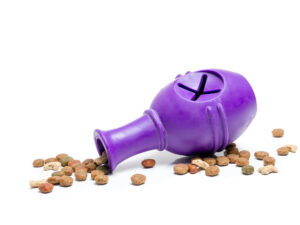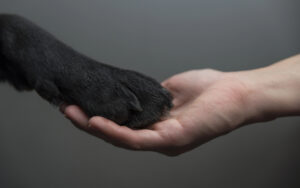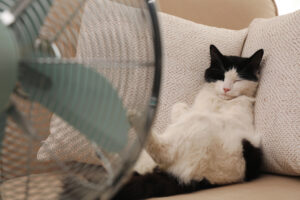
Preparing for Disasters: Tips & Dog Emergency Kits
It is our responsibility to ensure the safety and well-being of our pets during times of crisis or natural catastrophe. Many of us consider our beloved pets more than just animals; they are loved ones who complete our families and who are always there for us when we need them. It is our responsibility as conscientious pet owners to make sure our pets are physically and mentally ready to face any storm that comes their way.
Being pet emergency prepared is not only a recommendation; it’s a necessity in Southern California, where the threat of wildfires, earthquakes, hurricanes, and flooding is looming large. Fires, hurricanes, and other historical disasters show how devastating it can be when pet owners aren’t ready for emergencies.

Boarding Clients!*Discount does not apply during holiday/peak rate periods.

Creating a Pet Emergency Plan
The first step in being ready is making a detailed plan for your pet in the event of an emergency. You and your pet will be prepared for any emergency or disaster with this plan. In the event of an emergency involving your pet, the following should be carefully considered:
Identification:
- The key to finding a missing pet and getting it back to its owner is pet identification. Put your contact information on an up-to-date ID tag and make sure your pet wears a collar.
- Microchipping your pet is a long-term identification when collars get lost or damaged. It is important to maintain up-to-date contact details with the microchip manufacturer.
Communication and Contacts:
- Build a network of reliable people you can call on for help. Send them a copy of your pet’s emergency plan and swap contact details.
- You should have the number of your pet’s vet, a local shelter, and an emergency pet care service on hand.
Supplies:
- Make sure your pet is well-prepared in case of an emergency by assembling an emergency kit. Included in this kit should be food, water, medicine, first aid gear, and things to make you feel more comfortable.
- Keep supplies fresh and usable by checking on them often and restocking as needed.
Training and Preparation:
- Have your pet on the ready in an emergency, teach it the basics, like “come,” “sit,” and “stay.”
- To help your pet feel more comfortable and prepared for real emergencies, it’s a good idea to practice evacuation drills with them.
In the event of an emergency, you can better protect your beloved pet if you review and update your plan frequently.
Assembling a Pet Disaster Kit
If you care about your pet’s safety in case of an emergency, you should put together a pet disaster kit. Everything your pet could possibly need to stay healthy and comfortable for a long time should be included in this kit. The following items should be part of your pet’s emergency supply:
Food and Water:
- Put your pet’s usual food into a sealed bag or watertight container with enough for a week’s supply. Get foods that can be stored for a long time in a dry or canned form.
- Keep your pet hydrated for at least seven days by storing enough water to meet their daily demands.
Leash, Collar, and ID Tags:
- Make sure to bring a strong harness or leash, as well as a collar that is securely fastened and has current identification tags with your contact details.
- If your pet gets separated during an evacuation, these items will be essential for keeping them under control and getting them back safely.
Sanitation Supplies:
- If you’re traveling with cats, be sure to bring their litter box and litter, as well as puppy pads or newspaper for dogs, and trash bags for garbage disposal.
- For cleaning up spills and keeping things clean, have some paper towels, wet wipes, and disinfectant on hand.
Carrier or Crate:
- Make sure your pet has a safe and cozy place to sleep in while you’re on the go or in the shelter.
- Make sure there’s enough room in the carrier for your pet to move around and relax.
Medications and Medical Records:
- Be sure to bring your pet’s current prescriptions, any necessary medical records, and proof of vaccinations.
- For their protection, store these things in an airtight container that can withstand water.
Comfort Items:
- Incorporate items that are familiar to your pet, such as blankets, towels, toys, or clothing, that can offer solace and comfort in times of stress.
- In times of crisis, these things can help calm your pet and ease its anxiety.
First Aid Kit:
- Get together a pet first aid kit with all the necessary items to handle small injuries and medical emergencies.
- Bandages, gauze pads, antiseptic wipes, tweezers, and a first aid manual tailored to pets should be included.
In the event of an emergency, you can still provide for your pet’s needs by putting together a thorough pet disaster kit. To keep all of your supplies current, usable, and fresh, you should inspect and update your kit regularly.

Evacuating with Your Dog in an Emergency
Get out of there quickly if you and your pet are in danger during natural disasters like hurricanes, floods, earthquakes, or wildfires. For a safe evacuation with Fido, follow these steps:
Plan Ahead:
- Create a comprehensive escape strategy that incorporates your canine companion. Find out where to take shelter, how to evacuate, and whether any shelters will accept pets.
Keep Your Dog Secure:
- Make sure your canine is always wearing a strong collar that includes your contact information on a tag.
- Keep your dog from bolting or becoming lost during evacuations by keeping them under control with a leash or harness.
Prepare a Go-Bag:
- Make sure your dog has everything they need in their “go-bag”: food, water, medicine, a leash, a collar, identification, and a cozy blanket or toy to cuddle up with.
- Maintain easy access to this bag so that you can swiftly retrieve it if an evacuation order is issued.
Arrange Transportation:
- Before an evacuation, plan how you will get your dog to safety. Make sure your car is gassed up and in good working order if you own one.
- Make an effort to get in touch with people you know or the authorities in your area if you need assistance and do not have access to transportation.
Communicate with Authorities:
- If local authorities issue an evacuation order or other instructions, be sure to stay informed. Make sure you and your dog are safe by following their instructions.
- You should notify the emergency personnel if you require help evacuating your pet; they might be able to offer you transportation or other forms of support.
Stay Calm and Reassuring:
- Keep your cool during evacuations; dogs can sense when you’re upset. To maintain your dog’s composure and cooperation, speak to them in a soothing tone.
- As you guide your dog through the evacuation process, make sure to reassure and comfort him or her while also providing praise and encouragement when necessary.
Seek Pet-Friendly Shelters:
- Find lodgings or shelters that welcome pets so you can bring Fido with you when you evacuate. Do your homework on their pet policies and availability before you go.
- Think about staying with friends or family outside of the evacuation zone, pet-friendly hotels, or boarding facilities if shelters that accept pets are not available.
Follow Safety Protocols:
- Follow the authorities-mandated safety measures and evacuation routes. Stay safe and don’t put your dog or yourself in danger by doing things that aren’t necessary.
- If things change or if you encounter obstacles, you should be ready to change your evacuation plans.
Caring for Your Dog During a Natural Disaster
The safety of your dog can be guaranteed even in the most chaotic of situations if you are well-prepared and attentive to your pet before, during, and after a natural disaster. Important things to remember when caring for your dog in the aftermath of a natural disaster are:
Stay Informed and Prepared:
Always be aware of the weather warnings for your area, including those for hurricanes, earthquakes, wildfires, and floods. Make sure your dog is safe and taken care of in the event of an emergency by including their needs in your comprehensive plan.
Secure Your Home:
Make sure your house and possessions are safe from harm by taking preventative actions. To keep your dog safe during storms and tremors, make sure that his living space is clear of any loose objects that could become projectiles.
Maintain Emergency Supplies:
Make sure your dog always has plenty of food, water, medicine, and first aid supplies on hand in case of an emergency. To keep these items effective, store them in a container that can be waterproofed and make sure to refresh them regularly.
Evacuation Preparedness:
Get your dog’s identification tags and microchip information current, find pet-friendly shelters, and map out evacuation routes in case of an emergency. Get your dog used to the idea of an evacuation by doing practice runs with them.
Monitor Weather Updates:
Keep an eye on the weather reports and any evacuation orders issued by your government. To make sure your dog is safe, be ready to evacuate quickly if needed.
Provide Comfort and Reassurance:
Because of the unfamiliar environment and loud noises, your dog might feel anxious or stressed out during a natural disaster. Staying calm, being a reassuring presence, and offering familiar objects like blankets or toys can provide comfort and reassurance to your dog.
Be Alert to Signs of Distress:
In the event of a natural disaster, keep a careful eye on how your dog is acting. Be on the lookout for symptoms of pain or distress like pacing, shaking, or heavy panting, and react appropriately to calm them down.
Stay Together if Possible:
If you can, stay with your dog during a disaster so you can both offer immediate support and care. If you must evacuate, do not leave your dog behind; they could get lost or hurt if they are alone.
Follow Safety Guidelines:
Pay close attention to any safety instructions or guidelines given by authorities or emergency responders. Do not ignore evacuation orders or risk endangering yourself or your dog by going into dangerous areas.
Seek Assistance if Needed:
During a natural disaster, don’t be shy about asking your neighbors, friends, or animal welfare groups for help if you need it with your dog’s care. Work together with other people to make sure your pet is safe.

Frequently Asked Questions
How do I create an emergency plan for my dog?
To create an emergency plan for your dog, start by identifying potential risks in your area, such as fires, earthquakes, or floods. Develop a communication strategy and ensure your dog is microchipped and wearing identification tags. Establish evacuation routes and designate a meeting point. Prepare a disaster kit with essentials like food, water, medication, and comfort items.
What should I include in a pet disaster kit?
A pet disaster kit should include:
• One week’s supply of food and water
• Collapsible bowls
• Medications and medical records
• Leash, harness, and carrier
• ID tags and microchip information
• Blankets, towels, and bedding
• First aid kit
• Toys and treats for comfort
What steps should I take to evacuate with my dog safely?
When evacuating with your dog, ensure they are wearing a collar with identification. Pack your pet’s disaster kit and leash. Follow evacuation orders from authorities and use designated evacuation routes. Transport your dog in a secure carrier or on a leash. Keep them calm and comforted during the evacuation process.
Where can I find pet-friendly evacuation shelters?
Pet-friendly evacuation shelters vary by location. Check with local authorities, animal shelters, or emergency management agencies for information on designated pet-friendly shelters in your area. Some hotels or motels may also allow pets during emergencies.
Do shelters allow pets?
Yes, some shelters allow pets during emergencies. However, policies may vary depending on the shelter and the type of emergency. It’s essential to check with local authorities or visit official websites for up-to-date information on pet-friendly shelter options.
How can I care for my dog during a natural disaster?
During a natural disaster, prioritize your dog’s safety by keeping them indoors and away from windows. Provide access to food, water, and a safe, comfortable space. Keep your dog on a leash or in a carrier if evacuating. Monitor weather updates and follow instructions from authorities to ensure your dog’s safety.
What should I do if my dog gets lost during an emergency?
If your dog gets lost during an emergency, immediately notify local animal shelters, veterinary clinics, and animal control agencies. Search your neighborhood, distribute flyers, and use social media to spread the word. Contact microchip registries and online lost pet databases to report your dog missing.
How do I perform pet CPR and first aid?
Pet CPR and first aid training are essential skills for pet owners. Enroll in a certified pet CPR and first aid course to learn techniques for assessing your dog’s condition, performing CPR, managing injuries, and administering basic medical care until professional help arrives.
What training can I give my dog to prepare for emergencies?
Training your dog for emergencies involves teaching essential commands such as “come,” “stay,” and “heel.” Practice evacuation drills with your dog to familiarize them with the process. Consider enrolling in obedience classes or specialized training programs designed to prepare dogs for emergency situations.


















